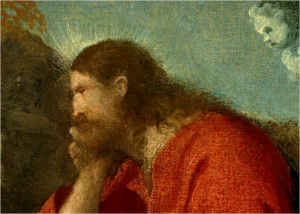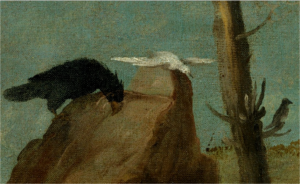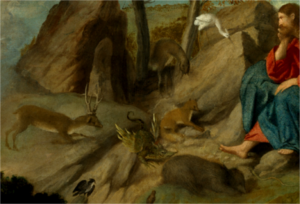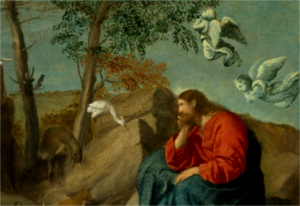Midway upon the journey of our lifeI found myself in a darkness wildFor I had wandered from the straight and right!
These are the opening lines of the first part (Inferno) of Dante’s epic work The Divine Comedy. Soon after awakening Dante finds himself at the foot of the hill. He looks up and sees the sun rising, its rays leading to heaven. Aspiring to follow the light he begins to ascend the hill rapidly. But Alas! out come the ravaging beasts – a leopard (fraud and vanity), lion (pride and violent ambition) and a she-wolf (incontinence).
Temptation is an integral part of human living. Right from Adam and Eve humanity always encountered temptation. Jesus Himself, led by the Spirit, goes into the desert in order to share in the temptations of the world.
The Gospel of Mark, unlike the other parallel Gospels, does not elaborate on the scriptural debate between the devil and Jesus. Mark simply mentions, “Jesus stayed in the desert for 40 days and was tempted by Satan.” Moretto da Brescia (1498-1554) in his “Christ in the Wilderness” shows Jesus with wild animals while the angels waited on him. The animals themselves form an important part of today’s painting and Dante’s Divine Comedy.
Animals, both real and mythical, occupied an important place in medieval art and thought. They served as symbols of virtues and vices. Biblical and religious references provided impetus to their employment. Documents known as bestiaries were collected and compiled. Church Fathers like St. Augustine, St. Ambrose and St. Gregory the Great used illustrations from these books as religious allegories for moral instructions.
 Consider the painting. Christ sits pensively on a rocky terrain punctuated by clefts. He seems fatigued and famished, withdrawn to silence and poverty. Two beech trees are planted in the center. The first is dead and dry. The second, fresh with green leaves, leans towards Jesus sheltering him from the scorching sun.
Consider the painting. Christ sits pensively on a rocky terrain punctuated by clefts. He seems fatigued and famished, withdrawn to silence and poverty. Two beech trees are planted in the center. The first is dead and dry. The second, fresh with green leaves, leans towards Jesus sheltering him from the scorching sun.
Mythically the beech tree is associated with the Roman god Jupiter. The tree derives its name from a Greek word that means “to eat,” reminding us of the nuts it provided the ascetics for their sustenance in the wilderness. This elucidates Christ’s abstinence for 40 days.
As Jesus dwells in solitude, a variety of “wild” creatures head towards him, each accompanied by its allegorical and moral symbolism. Let’s join their company and uncover their figurative tales.
 Perched on the rock is a bird in black. This is undoubtedly the raven. The raven stands for unrest, indifference and ill-fortune. According to the writings of St. Augustine, the raven is known for its “cras, cras,” which in Latin translates as “tomorrow, tomorrow.” This illustrates the very nature of Satan who deceives us with the lie of the future. No doubt the legends claimed, “Tomorrow never comes.”
Perched on the rock is a bird in black. This is undoubtedly the raven. The raven stands for unrest, indifference and ill-fortune. According to the writings of St. Augustine, the raven is known for its “cras, cras,” which in Latin translates as “tomorrow, tomorrow.” This illustrates the very nature of Satan who deceives us with the lie of the future. No doubt the legends claimed, “Tomorrow never comes.”
Next to the raven lies a white bird in flight. This could probably be the dove, a symbol of the Holy Spirit. The dove in the desert emphasizes and reassures us of the presence of God in our lives even in the midst of trials and temptations. The bird next to it on the twig of the parched tree is the goldfinch. It represents victory over death.
 Comprising the second group of beasts and birds is the crane, the pelican and the stag. According to the bestiaries, cranes sleep together in a group. Among the lot, one of them is chosen to keep a watch. Now in order to keep alert and avoid the temptation of sleep, the crane drops stones on its own foot. This exemplifies its loyalty and faithfulness to itself and others – a quality admired and desired by monks and ascetics.
Comprising the second group of beasts and birds is the crane, the pelican and the stag. According to the bestiaries, cranes sleep together in a group. Among the lot, one of them is chosen to keep a watch. Now in order to keep alert and avoid the temptation of sleep, the crane drops stones on its own foot. This exemplifies its loyalty and faithfulness to itself and others – a quality admired and desired by monks and ascetics.
Bending low by its side is the pelican. It was believed to wound itself in order to feed its young with its own blood. It liturgically expressed Christ sacrificing himself for man and thus became a symbol of atonement. The stag next to it stands for purity in times of persecution. Interestingly, as the bestiaries narrate, the stag is afraid of every other creature except the snake. It has the ability and passion to destroy it.
The next band of beasts are the wily and the crafty ones. They include the fox, the basilisk, the bear and the adder. Thanks to its ever scheming nature, the fox is the perfect symbol for Satan who is always on the prowl to strike those who succumb. On its right is the mythical creature, the basilisk. It derives its name from the Greek word “basiliscu,” meaning “little king.” It is acclaimed as the king of the serpents.
The bear stooping before Jesus symbolizes evil. Its cruelty is observed in the 2 Kings 2:24, where God protects Prophet Elisha’s integrity at Bethel by sending two female bears that promptly eat the youth who poked fun at him. The adder, right in front of the bear, is a serpent with a deadly bite. Representing ardent sin, it is often depicted crushed by the feet of Jesus.
 The last group consist of the black bird (known for its enticing song), the jay (symbolic of gossip), the phoenix (a reminder of the resurrection) and the lion (alertness and watchfulness). Thus through their appealing allegories the beasts and birds bring out the essence of the Gospel narrative and the substance of art.
The last group consist of the black bird (known for its enticing song), the jay (symbolic of gossip), the phoenix (a reminder of the resurrection) and the lion (alertness and watchfulness). Thus through their appealing allegories the beasts and birds bring out the essence of the Gospel narrative and the substance of art.
The painting is a part of a larger scene. This is affirmed by the presence of the two small swirling cherubs on the left. They probably formed the aureole for God the Father. This also explains Christ’s direction of view. In the desert, starved and strained, Jesus still fixes his gaze on His Father and invites us to do the same.
Notice the posture of every animal. Each of them is turned towards Jesus bending low, some in submission and others in adoration. This clearly connotes Christ victory over sin and temptation. The key is to turn and submit to Him in times of trials. For a trial is not being punished by an angry God rather being pruned and pursued by a loving God!
This article was published in partnership with Indian Catholic Matters.

